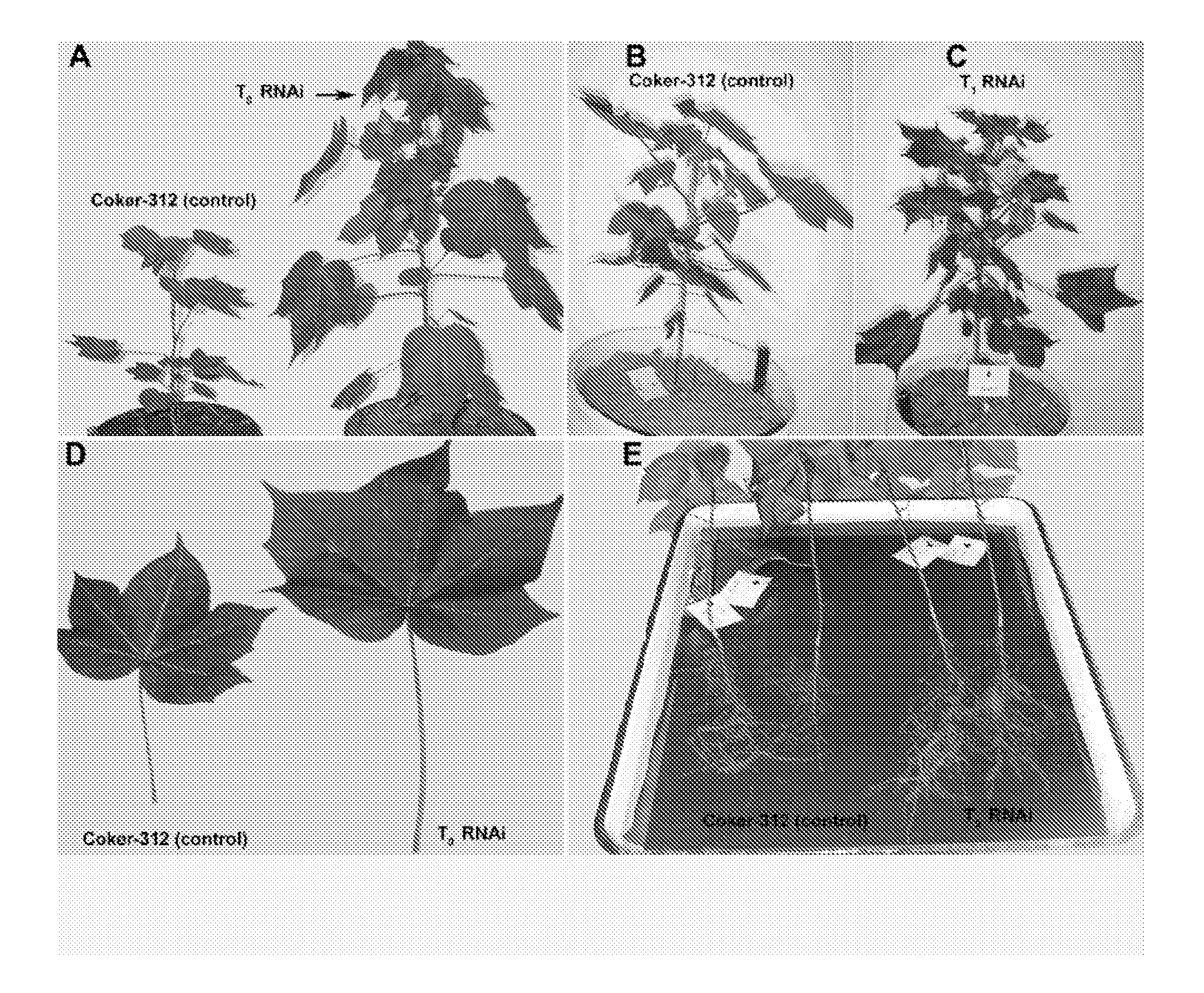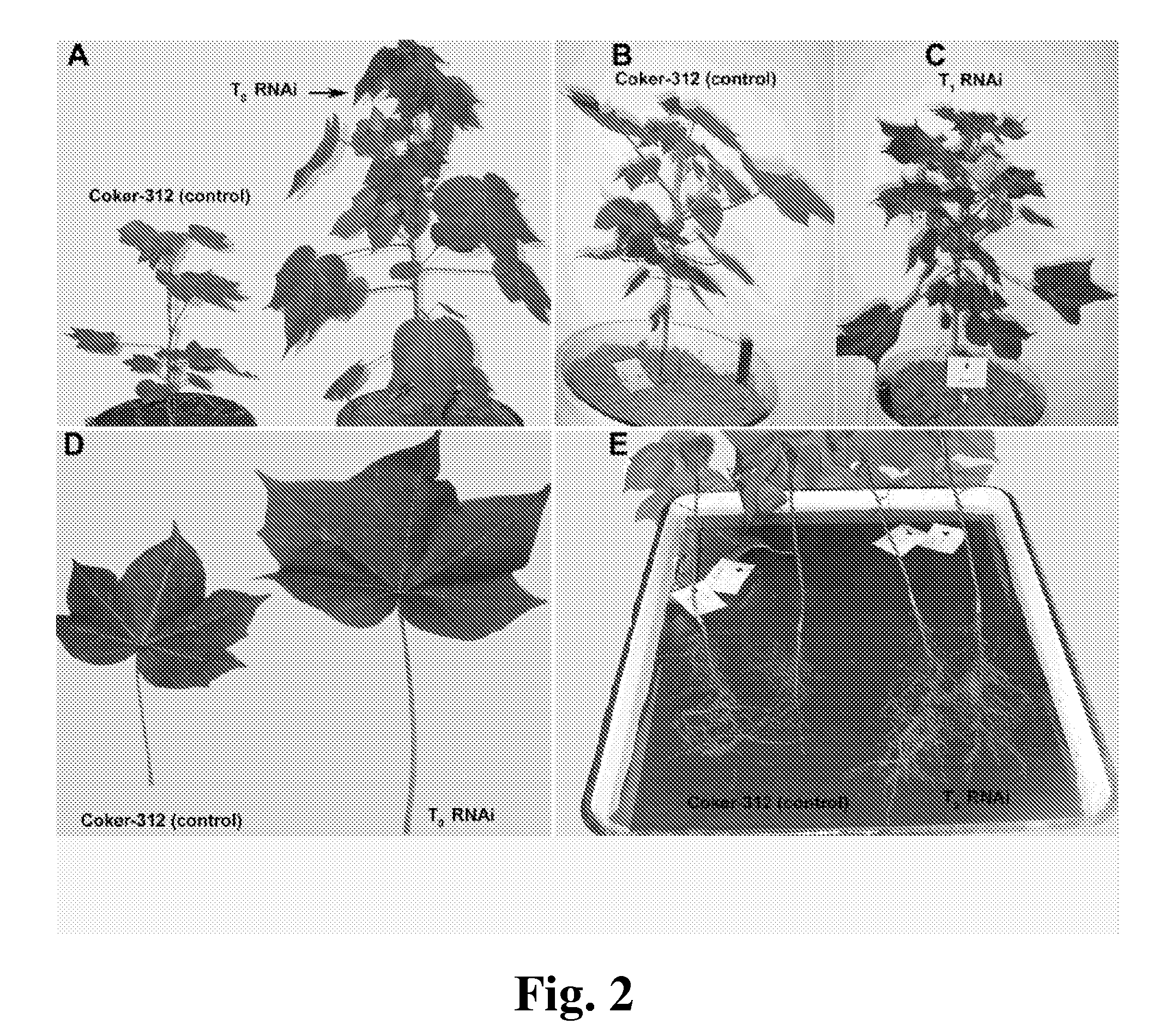Cotton PHYA1 RNAi Improves Fiber Quality, Root Elongation, Flowering, Maturity and Yield Potential in Gossypium hirsutum L.
a technology of gossypium hirsutum and phya1, which is applied in the field of phytochrome genes, can solve the problems of major fiber quality problems, and achieve the effects of enhancing the expression of other phytochrome genes, promoting senescence-enhanced anthocyanin pigmentation in stems, and vigorous vegetative growth
- Summary
- Abstract
- Description
- Claims
- Application Information
AI Technical Summary
Benefits of technology
Problems solved by technology
Method used
Image
Examples
example 1
Plant Material
[0095]Plant materials used here in this study were the somatically regenerable cotton genotype Gossypium hirsutum line Coker 312 and its transgenic derivative lines, transformed with pHellsgate-8::PHYA1 vector. Regenerable Coker-312 seeds (provided by Dr. Keerti Rathore, Texas A&M University, College Station, Texas, USA). To check the transferability of the RNAi effects observed, we used several commercially important Uzbek cotton cultivars, e.g., G. hirsutum cv. AN-Boyovut-2 for the conventional genetic hybridization experiments with RNAi Coker-312 plants.
example 2
RNAi Vector Construction
[0096]We constructed a PHYA1 gene-specific RNAi binary vector construct using high-throughput pHellsgate-8 GateWay plasmid vectors (provided by Dr. P. Waterhouse and Dr. C. Helliwell, CSIRO, Australia) (Wesley et al., supra; Helliwell et al., supra). RNAi vectors were transformed into the A. tumefaciens strain LBA4404 and used for plant transformation experiments.
[0097]For the attB site (attB1 and attB2) of the cotton PHYA1 gene, the attached gene-specific primers, Gos_PHYA1attB1-F and Gos_PHYA1attB2-R (Table 1) were designed and purchased from Integrated DNA Technologies Inc. (Iowa, USA). These primer pairs specifically amplified the 213 bp PHYA1 gene fragment (SEQ ID NO:1) of cotton which corresponds to a portion of the hinge region of the cotton phytochrome A genes. It is noteworthy to mention that tetraploid cottons have two different PHYA1 gene, one acquired from the diploid D-genome ancestor and the other, from the diploid A genome ancestor (Abdurakhmon...
example 3
Cotton Transformation and Somatic Embryogenesis
[0099]For cotton transformation and somatic embryogenesis, we used the methodology of Sunilkumar and Rathore (2001. Mol. Breeding. 8:37-52) modified with regard to the plant regeneration medium based on other tissue culture studies in cotton (Stewart and Hsu. 1977. Planta 137:113-117; Firoozabady et al. 1987. Plant Mol. Biol. 10:105-116). All reagents for cotton tissue culture were purchased from Phytotechnology Laboratories®, USA. The T0 plantlets were transferred into soil in pots and grown in a greenhouse environment in 2008.
[0100]Sulfuric acid delinted cottonseeds of Coker-312 were surface sterilized in 10 minute wash with 70% ethanol and briefly burned under the hood to remove the ethanol traces. Seeds were planted into 0.7% agar medium and kept under the dark condition for 3 days at 28° C. for germination. Germinated seeds were placed under a photoperiodic condition of 16 hours light followed by 8 hours dark for the development of...
PUM
| Property | Measurement | Unit |
|---|---|---|
| temperature | aaaaa | aaaaa |
| Tm | aaaaa | aaaaa |
| temperatures | aaaaa | aaaaa |
Abstract
Description
Claims
Application Information
 Login to View More
Login to View More - R&D Engineer
- R&D Manager
- IP Professional
- Industry Leading Data Capabilities
- Powerful AI technology
- Patent DNA Extraction
Browse by: Latest US Patents, China's latest patents, Technical Efficacy Thesaurus, Application Domain, Technology Topic, Popular Technical Reports.
© 2024 PatSnap. All rights reserved.Legal|Privacy policy|Modern Slavery Act Transparency Statement|Sitemap|About US| Contact US: help@patsnap.com










